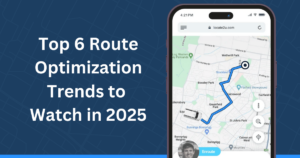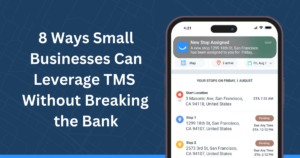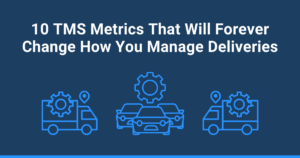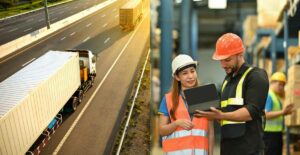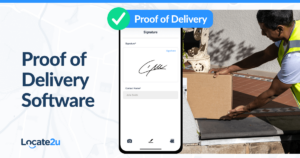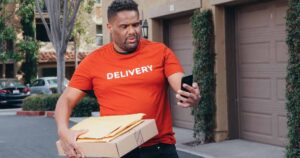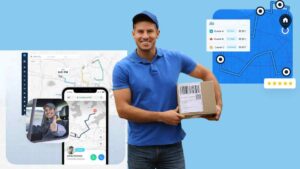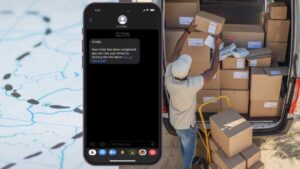Trustworthiness and transparency are crucial for online shoppers; 60% consider them the most important traits of a brand. Despite this, many businesses still don’t use live real time tracking software.
With real-time tracking creates open communication, especially when delays are expected, leaving customers to mitigate their expectations and emotions.
Imagine a small jewelry business trying to ship out orders in time for the holidays. Without live tracking, the owner sends off packages, hoping they arrive on time. But there’s no way to inform customers of delays.
Worse, one customer plans to be away for a holiday trip and misses the package altogether.
Live tracking could have shown the exact status of each delivery, allowing both the business and customers to plan better, avoid disappointment, and ensure gifts arrive when they’re needed most.
In this article, you’ll learn how different industries can benefit from real-time tracking and how to increase communication, productivity, and customer service.
What is real-time tracking?
Real-time tracking is the ability to track the location of a parcel, person, or vehicle in real time.
How is that done? With GPS tracking software. The system continuously monitors the target and provides location data.
In the logistics world, you might want to track your delivery drivers and assets, such as equipment or a delivery van or vehicle.
Delivery drivers use a mobile app that shares a live location with the customer. For assets like vehicles or equipment, hardware is installed.
There is a variety of hardware, some smaller, others more rugged, and some with better battery life.

The accurate and updated information is constantly communicated with the office and customer in real time.
This allows customers and managers to make informed decisions and adjust plans if needed.
How real-time tracking has changed industries
Parcel theft has been on a steady rise over the years, which is a growing concern for businesses and customers.
A study by Food Logistics found that 80% of respondents cite loss prevention and cross-border shipping challenges as the main reasons businesses insist on using real-time visibility.
Real time tracking is used not only for better customer service during the last mile but has also changed how fleet managers and delivery managers operate daily.
Fleet manager’s day made easier with tracking
Vehicle performance, safety, and driver behavior are all improved by using live tracking on the fleet.
Fleet managers can now monitor the engine health, fuel efficiency, and vehicle diagnostics instantly. This ensures the car drives longer and is well maintained, and the drivers can be trained if they are potentially damaging the vehicles.
Want to learn more about fleet management software? What is fleet management software?
How does live tracking improve delivery?
When delivery drivers have to instantly reroute drivers when a new order/ stop pops up, a dispatch and delivery manager has to be able to quickly reroute or delay certain deliveries.
With real-time tracking, managers are able to use route optimization software. This way, drivers will be able to take the most efficient routes, saving time and fuel.
It also enables drivers to deliver orders faster.
Want to learn more about dispatch and delivery management software? What is dispatch and delivery management software?
The role of real-time tracking in the logistics industry

Optimizing route planning
Locate2u CEO Steve Orenstein says it’s all about the customer experience. The last thing you want as a business is for your customer to wait all day for their parcel.
“To be able to tell your customer when you’re arriving, you need to send them a tracking link that can be updated in real time as the driver is actually moving throughout the day,” says Orenstein.
But to tell your customers you are arriving at 2 p.m. in the afternoon, you need route optimization. “You need to know the order in which the driver is actually going to complete the delivery.”
Reducing delivery times and increasing customer satisfaction
Customers want fast deliveries. They don’t want to wait for their parcel. That’s why same-day or next-day deliveries are increasingly popular. And customers are even willing to pay more for faster deliveries.
While the e-commerce market is growing rapidly, more than 30% of shoppers are drawn to sites that offer next-day delivery.
With real time tracking and route optimization software, customers receive their orders faster, ultimately increasing their satisfaction with the brand.
“It’s having a solution that allows a customer to see when you’re arriving through the tracking link, but also having the backend system to manage route optimization for all your deliveries and a mobile app for your drivers,” explains Orenstein.
Minimizing loss and theft in supply chain management
Online shoppers spent the most on electronics, which is estimated to bring in $922.5 billion in sales this year.
These electronics are seen as soft targets for theft. However, with real time tracking there are three advantages.
- It enhances visibility
- Improves the response to theft
- Serves as a deterrent
The thought that parcels are being actively tracked in real-time discourages potential thieves.
With real-time data, companies can act quickly when theft is suspected. If a vehicle or parcel is off-route or inactive for too long, companies can track it down before it’s lost entirely. This proactive approach minimizes the time window during which a theft could happen.

Enhancing e-commerce with real-time tracking
There are over 26.6 million e-commerce stores globally. More businesses are realizing that customers want to be part of the entire last mile process. When a company is transparent they are more likely to buy again.
But how can a live tracking link change the experience for a customer?
Improving last-mile delivery operations
Customers have a better experience when drivers know exactly when the parcel is heading their way, and the business also benefits. You don’t have customers ringing your call center to say where is my delivery?
With real time tracking, a dispatch and delivery manager can respond to delays faster. Drivers can be rerouted, and customers can be notified within seconds.
Offering real-time delivery updates to customers
Customers have certain expectations when they hold their purchased item in their hands. When those expectations are not met, frustration creeps in.
Open communication helps build trust with customers. If shoppers are informed about their delivery status via SMS or app notification, it helps build long-term loyalty.
Managing returns more efficiently
Real time tracking helps to make the return process run smoothly, keeping customers up to speed when a driver arrives to fetch their parcel to be returned.
It also helps with faster processing, which leads to customers having their money back much faster.
The same applies to the safety of an item when returned. Having a tracker on the item, especially for expensive items, results in fewer theft incidents.
Real-time tracking in healthcare and medical logistics

In the medical field, time is everything. A few extra minutes can save a patient’s life.
Medical teams use live tracking to monitor the real-time location of ambulances, ensuring faster response times and better coordination during emergencies.
When it comes to sensitive medical supplies such as vaccines and vital organs, live tracking can help the hospital know when the medical van is close by.
Route optimization also plays a vital role in making sure the vans don’t get stuck in traffic.
Managing patient transportation and ambulance services
Patient Transport Services Queensland (PTSQ) uses live tracking to transport patients in a specialist vehicle to hospitals or health facilities.
PTSQ specializes in non-emergency transport for those who need more than a taxi to visit a hospital or aged care facility. It’s a comfortable ride with medical equipment like oxygen and other medical necessities.
Initially, they used paper and spreadsheets to organize customer transport. It took a lot of their time.
Tracking vehicle locations and providing an accurate ETA to patients waiting for healthcare was difficult.
Now they use real time tracking and can easily track where their vehicles are throughout the day.
Real-time tracking in frozen food industry
Imagine transporting frozen food on a hot summer’s day in the back of a van. When the truck stops at the customer’s home, there is no one there. He had been waiting all day for the parcel and had to step out for a moment.
As per the customer’s instructions, frozen food is left. However, only half an hour of exposure to the heat could cause a lot of damage to the product and business.
With a tracking link, a customer can plan exactly when to be home and put the order in the fridge before leaving the house.
Maleny Food Co is an artisanal gelato and sorbet producer in Australia. They started off back in 2001, and as the demand from restaurants grew, they realized they needed help.
Because they had no real-time tracking, customers would call to ask when they could expect their deliveries. Maleny Food Co had to ring the drivers directly to check how far the delivery process was.
Now that they use route optimization and live tracking, it’s all changed: “It was more about the visibility of what was going on, both before the driver went out, whilst the driver was out and potentially looking back at information later,” says director Norman Scott.
Real-time tracking in the warm food industry
Keeping food fresh and warm requires precise planning and making sure meals arrive on time. Failing to keep within the time window, can compromise the quality of food.
With tracking, customers can monitor when food deliveries are made, reducing anxiety (especially when they are hungry).
Using the software helps to reduce food waste. None of the orders go to the dustbin, as delays are completely avoided.
Real-time also helps to minimize delivery windows and maximize the kitchen’s efficiency.
Why mobile bakery shares live location
Here’s a fresh idea: A bakery in Canberra, Husk Bakery, has been using live tracking to get customers to buy from their mobile bakery on wheels, on the road, by sharing their location on their Facebook page.
Customers are then able to track the van’s location and route to see where it’s heading. To make a purchase.
The role of real-time tracking for service providers
Service providers like plumbers or electricians use live tracking to improve appointment accuracy.
Customers are provided with precise arrival times, reducing the waiting time. It’s also brilliant for job management.
It helps with allocating jobs more efficiently and monitoring when service is completed to move on to the next customer.
By monitoring the employee, delivery managers can easily see which staff member is available to assist with the next order in the area.
Accountability with live tracking
Bendigo Professional Cleaning Services BPCS uses a GPS tracker to stop employees from extended breaks.
Owner and operator, Jess Johnson, used to have no way of knowing where her employees were at any given point in the day. This made it hard to tell customers when jobs were getting done with any certainty.
But with live tracking, it has changed.
The role of real-time tracking in construction
You would think no one would want to steal bulky construction equipment. But these guys have a significant price tag, making them a definite target.
According to recent statistics, construction equipment theft costs up to $1 billion in the US every year.
Construction companies use real time tracking to monitor the location and usage of their machinery and vehicles. This reduces theft and misuse.
Preventing delays in construction with GPS tracking
Construction companies are always blamed for projects dragging on – well over the deadline set out. But tracking helps to ensure essential equipment is always in the right place. This prevents costly job site delays.
Usage data used for maintenance in construction
Using real-time data to schedule preventative maintenance based on the actual day’s equipment was used can save the business time and money.
Managers can reduce breakdowns and extend equipment life by knowing exactly when and for how long equipment is used.
NOW READ: How to choose the best proof of delivery app
About the author
Mia is a multi-award-winning journalist. She has more than 14 years of experience in mainstream media. She's covered many historic moments that happened in Africa and internationally. She has a strong focus on human interest stories, to bring her readers and viewers closer to the topics at hand.



